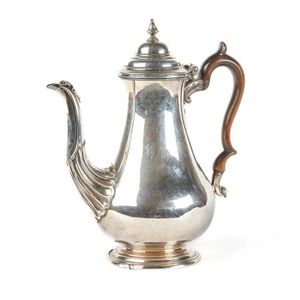1830 Sheffield Plate Coffee Pot with Rosewood Handle
You must be a subscriber, and be logged in to view price and dealer details.
Subscribe Now to view actual auction price for this item
When you subscribe, you have the option of setting the currency in which to display prices to $Au, $US, $NZ or Stg.
- Circa - A Latin term meaning 'about', often used in the antique trade to give an approximate date for the piece, usually considered to be five years on either side of the circa year. Thus, circa 1900 means the piece was made about 1900, probably between 1895 and 1905. The expression is sometimes abbreviated to c.1900.
- Sheffield Plate - Sheffield plate was the first commercially viable method of plating metal with silver. The method of plating was invented by Thomas Boulsover, a Sheffield Cutler, in 1743 and involved sandwiching an ingot of copper between two plates of silver, tightly binding it with wire, heating it in a furnace and then milling it out in to sheet, from which objects could be made.
Originally used by its inventor to make buttons, the potential of the material was quickly realised, and soon it was being used to fashion boxes, salvers and jugs, and not long after that candlesticks and coffee pots, and other traditional tableware.
Although there was a considerable saving in the amount of silver used, Old Sheffield Plate manufacture was more labour intensive than solid silver, meaning higher labour costs. This meant that Old Sheffield Plate was very much a luxury product, and only available to the very wealthy.
The thickness of the silver means that many 18th century Sheffield Plate pieces still have a good layer of silver, while electroplated pieces (EPNS), may have been replated several times over their lifetime. Where the silver has worn off the Sheffield plate the soft glow of the copper base can be seen underneath. However this is not an infallible guide that the piece is Sheffield Plate, as many EPNS items were also plated on to a copper base.
Most Sheffield plate items are unmarked, whereas most elecroplated items display manufacturers names or marks, quality indications such as "A1", "EP", together with pattern or model numbers.
Sheffield plate was made commercially between 1750 and 1850. - Rosewood - A dense timber that varies in shade to very light brown to almost black. When rosewood is cut and sanded the colour of the timber will turn black, and after polishing and exposure to daylight, the surface will gradually lighten over time to light brown with black streaks.
The name comes from the odour emanating from the timber when it is planed, sanded or cut.
Rosewood was very popular for use in Victorian furniture in the second half of the 19th century, and at that time most of the rosewood was imported from Brazil. However it also grows in India and Indonesia.
It is used in the sold for chairs and table legs, but for carcase furniture such as side cabinets and bookcases, and for table tops it is always used as a veneer.
This item has been included into following indexes:
Visually similar items

An unusual William IV period fiddle pattern silver caddy spoon, finely engraved with fluted decoration and fine engraving. Birmingham 1832 by James Collins. Length 7 cm

A fine quality Meiji period Satsuma vase, of square tapering form, decorated with florals on all sides, gilded and coloured geometric forms to top, the base marked with the Shimazu mon, artist's signature and Hodada (Tokyo Studio) mark. Height 15 cm

A George II silver toddy ladle, with pouring spout and a long twisted baleen handle, the coin in the base dated 1757. Length 34.5 cm

Vintage French bombe shape four drawer commode, approx 85 cm high, 120 cm wide, 65 cm deep
